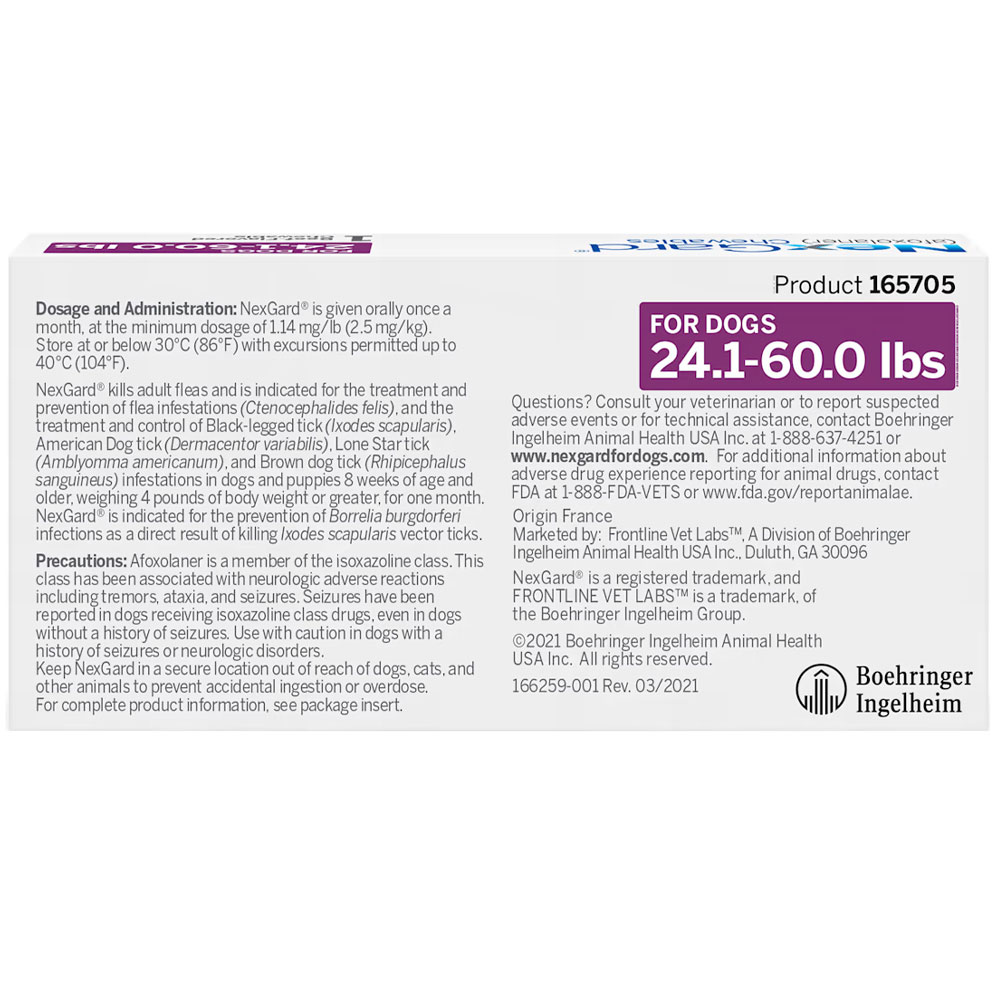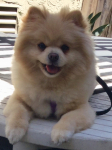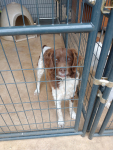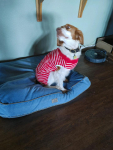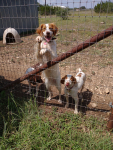SAVE 20% OFF 20% OFF Use Code NY26 *
NexGard Chewables for Dogs - afoxolaner - 24.1-60 lbs (1 chew) - [Flea & Ticks]
- Notice
- Description
- Ingredients
- Directions
- FAQ
- Reviews
Notices
NEXGARD ON SALE! Discounted price can be seen in cart.
Description
NexGard Chewables for Dogs
NexGard Chewables is a fast-acting, monthly flea and tick treatment for dogs. This beef-flavored chewable tablet kills fleas within 4 hours and ticks within 8 hours, providing rapid and lasting protection. NexGard is effective against fleas and multiple tick species including the American dog tick, black-legged tick, and Lone Star tick.
Suitable for dogs 8 weeks and older weighing at least 4 pounds, NexGard is easy to administer and can be given with or without food. As a prescription-only medication, it should always be used under veterinary supervision.
Key Features:
- Monthly Protection: One chewable provides 30 days of protection against fleas and ticks.
- Fast-Acting: Begins killing fleas within 4 hours and ticks within 8 hours.
- Easy to Give: Flavored chewable that dogs readily accept.
- Safe and Approved: FDA-approved for dogs 8 weeks and older, weighing 4+ pounds.
- Veterinary Supervision: Requires a prescription from your veterinarian.
Indications:
NexGard is indicated for:
- Flea Infestations: Kills adult fleas (Ctenocephalides felis) before they lay eggs, disrupting the flea life cycle.
- Black-Legged Ticks (Deer Ticks): Controls Ixodes scapularis, a vector of Lyme disease and anaplasmosis.
- American Dog Ticks: Effective against Dermacentor variabilis, which can spread Rocky Mountain spotted fever.
- Lone Star Ticks: Targets Amblyomma americanum, known for transmitting ehrlichiosis and other tick-borne illnesses.
Note: NexGard is for dogs only. Do not use in cats or other pets.
How NexGard Works:
The active ingredient, afoxolaner, belongs to the isoxazoline class of compounds and is both an insecticide and acaricide.
- Absorption: After ingestion, afoxolaner is absorbed into your dog’s bloodstream.
- Neurological Disruption: Afoxolaner blocks GABA and glutamate-gated chloride channels in parasites, disrupting nerve transmission.
- Paralysis and Death: This disruption causes hyperexcitation, paralysis, and death of fleas and ticks.
- Quick Onset: Fleas are killed within 4 hours; ticks within 8 hours. Effects last a full month.
- Consistent Dosing: Administer monthly to maintain protection and prevent reinfestation.
While NexGard is generally well tolerated, some dogs may experience mild side effects. Always consult your veterinarian before starting or continuing treatment.
Specifications:
- Active Ingredient: Afoxolaner
- Form: Flavored chewable tablet
- Strength: Varies by dog weight
- Route: Oral administration
- Flea Killing Speed: Begins within 4 hours
- Tick Killing Speed: Begins within 8 hours
- Protection Duration: 30 days
- Recommended For: Dogs 8 weeks+ and ≥4 lbs
- FDA Approved: Yes, for canine use
- Flavor: Beef-flavored for easy dosing
- Packaging: Available in multiple strengths for different weight ranges
Ingredients
| NexGard Chewables for Small Dogs 4-10 lbs | |
|---|---|
| Active Ingredient (per tablet) | Amount |
| Afoxolaner | 11.3 mg |
| NexGard Chewables - For Medium Dogs 10.1-24 lbs | |
| Active Ingredient (per tablet) | Amount |
| Afoxolaner | 28.3 mg |
| NexGard Chewables - For Large Dogs 24.1-60 lbs | |
| Active Ingredient (per tablet) | Amount |
| Afoxolaner | 68 mg |
| NexGard Chewables - For Extra Large Dogs 60-121 lbs | |
| Active Ingredient (per tablet) | Amount |
| Afoxolaner | 136 mg |
Directions
View NexGard Drug Facts Sheet (PDF)
NexGard is a convenient, once-a-month oral chewable that offers effective protection against fleas and ticks in dogs. It is administered at a minimum dosage of 1.14 mg/lb (2.5 mg/kg).
NexGard Dosage by Dog Weight:
| Dosing Schedule: | |||
|---|---|---|---|
| Body Weight | Afoxolaner Per Chewable (mg) | Chewables Administered | |
| 4.0 to 10.0 lbs | 11.3 | 1 Orange | |
| 10.1 to 24.0 lbs | 28.3 | 1 Blue | |
| 24.1 to 60.0 lbs | 68 | 1 Purple | |
| 60.1 to 121.0 lbs | 136 | 1 Red | |
| Over 121.0 lbs | Administer the appropriate combination of chewables | ||
Administration Instructions:
NexGard can be given with or without food. Ensure the entire chewable is consumed. Observe your dog briefly after administration. If vomiting occurs within two hours or if any dose is lost, administer another full dose. If a dose is missed, give NexGard as soon as remembered and resume the regular monthly schedule.
Flea Treatment & Prevention:
NexGard may be started at any time of year. In areas with year-round flea activity, continuous monthly treatment is recommended. All household pets should be treated with an approved flea control product to prevent reinfestation.
Tick Treatment & Control:
NexGard may be administered at any time of the year. Refer to the Effectiveness section for details on tick species.
Contraindications:
There are no known contraindications for NexGard use.
Warnings:
Not for human use. Keep out of reach of children. In case of accidental ingestion, contact a physician immediately.
Precautions:
The safety of NexGard has not been evaluated in breeding, pregnant, or lactating dogs. Use with caution in dogs with a history of seizures (see Adverse Reactions).
Adverse Reactions:
In a U.S. field study, no serious adverse reactions were observed. The most common reaction was vomiting, which was self-limiting and decreased over time. Other reactions reported in more than 1% of dogs included anorexia and lethargy.
Reported Adverse Reactions:
| Dogs With Adverse Reactions. | ||||
|---|---|---|---|---|
| Treatment Group | ||||
| Afoxolaner | Oral active control | |||
| N1 | % (n=415 | N2 | % (n=200) | |
| Anorexia | 5 | 1.2 | 9 | 4.5 |
| Vomiting (with and without blood | 17 | 4.1 | 25 | 12.5 |
| Dry/Flaky Skin | 13 | 3.1 | 2 | 1.0 |
| Diarrhea (with and without blood) | 13 | 3.1 | 7 | 3.5 |
| Lethargy | 7 | 1.7 | 4 | 2.0 |
1 Number of dogs in the treatment group with reported reaction.
2 Number of dogs in the control group with reported reaction.
Seizures were reported in a few dogs with a prior history of seizures. To report adverse events, contact Merial at 1-888-637-4251 or visit merial.com/nexgard. Alternatively, report to the FDA at fda.gov/AnimalVeterinary/SafetyHealth or call 1-888-FDA-VETS.
Mode of Action:
Afoxolaner, part of the isoxazoline class, targets ligand-gated chloride channels (GABA receptors) in insects and acarines, causing hyperexcitation and death. It exhibits selective toxicity due to its lower binding affinity in mammalian GABA receptors.
Effectiveness:
Laboratory studies show NexGard begins killing fleas within 4 hours and achieves over 99% effectiveness within 8 hours. It remains 100% effective against adult fleas for up to 35 days and maintains ≥93% effectiveness through Day 35. It is also effective against Dermacentor variabilis, Ixodes scapularis, Rhipicephalus sanguineus, and Amblyomma americanum ticks.
A U.S. field study showed >98% effectiveness against fleas on Days 30, 60, and 90. NexGard kills fleas before they can lay eggs, preventing reinfestation.
Animal Safety:
Safety studies in puppies showed no clinically significant effects at doses up to 5 times the maximum recommended. NexGard was safely used with commonly prescribed veterinary medications.
Storage:
Store at or below 30°C (86°F) with excursions permitted up to 40°C (104°F).
FAQ
Reviews
- Sometimes the tic falls onto the floor and acts half drunk & is still alive for a few hours. Even if they get on me or another animal they dont have the strength to bite.
- I would neither recommend or not recommend this product until after using NexGard (and HeartGard Plus) for six months.
- Delivery
- Easy to give to him. He loves the taste and it is only once a month treatment.
- Pricey
- Taste
- Cost
- Works great with no side effects.
- None
- The only con I have is with Entirely Pets slow motion delivery service! This is not a good thing. We ordered both prescription and non prescription items, took too long!














